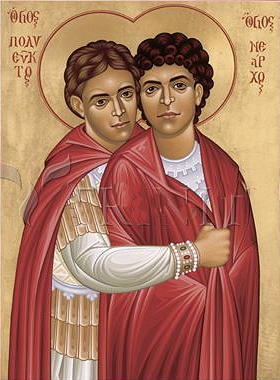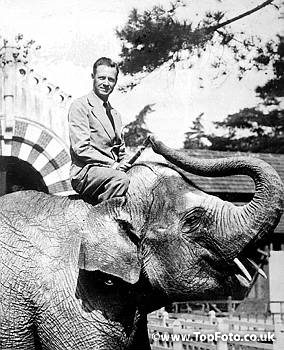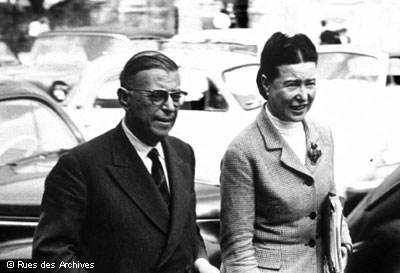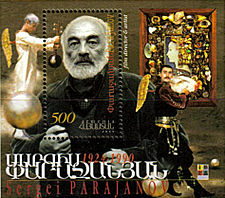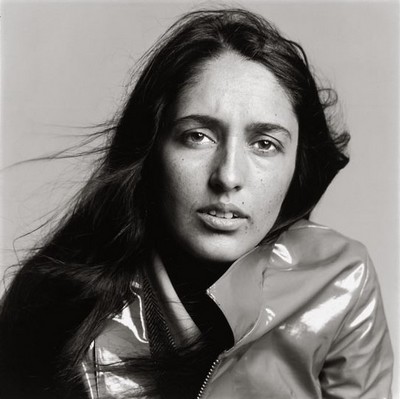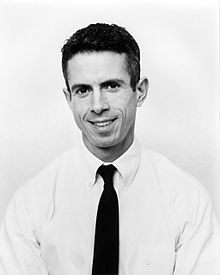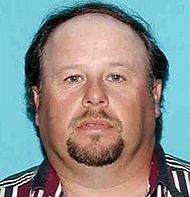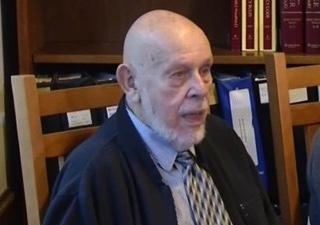|
presents THIS DAY IN GAY HISTORY based on: The White Crane Institute's 'Gay Wisdom', Gay Birthdays, Gay For Today, Famous GLBT, glbt-Gay Encylopedia, Today in Gay History, Wikipedia, and more …
Collected by Ted January 9 [{(o)}]|[{(o)}]|[{(o)}]|[{(o)}]| [{(o)}]|[{(o)}]
259 – Died: Saint Polyeuct, lover of Saint Nearchus. Soldiers in the Roman army and deeply attached to each other, Polyeuct and Nearchus were both stationed in Militene, Armenia. The earliest account of Polyeuct's martyrdom was written by Nearchus. The primary thread of their story is the desire of these two friends to spend eternity together. According to the text, when the emperor issued a new edict against Christians, Nearchus was worried that, since Polyeuct was a pagan and Nearchus a Christian, his own possible martyrdom and the eventual death of Polyeuct might lead to their being in separate places in the afterlife. Polyeuct reassured him that he had long been drawn to Christianity and intended to die a Christian. With a convert's fervor, Polyeuct then attacked a pagan procession and had himself arrested. The judge turned out to be his own father-in-law, Felix, who begged him to reconsider. Polyeuct's wife, Paulina, came to court and unsuccessfully implored him, for the sake of their marriage and their son, to change his mind. After severe tortures, he was condemned to death. Just before he was beheaded, Polyeuct saw Nearchus near. His final words to Nearchus were "Remember our secret vow." Nearchus was later martyred, being buried alive. Before his own death, Nearchus recorded this story, which was recounted annually at the church at Militene and eventually erected over Polyeuct's tomb in Militene. In the year 527, a great church with a gold-plated ceiling was built in Constantinople and dedicated to St. Polyeuct. Later in the same century, Gregory of Tours wrote that the most solemn oaths were usually sworn in this church; because Polyeuct had come to be considered the special heavenly protector of vows and avenger of broken promises.
1857 – Henry Blake Fuller (d.1929) was an American novelist and short story writer, born in Chicago, Illinois. Fuller's earliest works were travel romances set in Italy that featured allegorical characters. Both The Chevalier of Pensieri–Vani (1890) and The Châtelaine of La Trinité (1892) bear some thematic resemblance to the works of Henry James, whose primary interest was in the contrast between American and European ways of life. Fuller's first two books appealed to the genteel tastes of cultivated New Englanders. Fuller then turned to literary realism, writing The Cliff-Dwellers (1893), what is perhaps the first novel set among the skyscrapers and frenetic business culture of modern-day Chicago. The novel shocked and outraged Chicago readers, who found its unflattering portrait of the city jarring. Perhaps his finest achievement is the controversial Bertram Cope's Year (1919), a subtle novel about homosexuals. Fuller self-published the novel in Chicago after unsuccessfully making the rounds of several New York publishing houses. Set on the campus of Northwestern University in Evanston, Illinois, it featured an attractive young English instructor who becomes the elusive object of desire for several young women and at least two men of different ages. Cope's primary emotional attachment is to his effeminate college chum Arthur Lemoyne, who comes to Evanston to live with Cope until Lemoyne is expelled from the campus for making a backstage pass at another male student while dressed as a woman. The novel ends on an ambiguous note concerning the issue of Cope's sexuality. It received less than enthusiastic reviews from critics who did not understand the book's satirical intentions. It puzzled critics and embarrassed his friends. Upon its republication in 1998, it received enthusiastic reviews. Fuller never married. His journals from his teenage days make it clear he was in love with some dormitory roommates at Allison Classical Academy. At the age of nineteen, he wrote in an imaginary personal advertisement: "I would pass by twenty beautiful women to look upon a handsome man". At the age of 34 he wrote that he was in love with an adolescent boy who had blue eyes and strawberry blonde hair. Five years later, Fuller wrote and published a short play, At Saint Judas's, about a homosexual who commits suicide at the wedding of his former lover. It is credited with being the first American play dealing explicitly with homosexuality. In 1924 Fuller embarked upon the last of his many European tours with William Emery Shepherd, a 24-year-old college student. Their letters do not indicate their relationship was anything but a friendship. The trip exhausted Fuller, who continued writing literary reviews for a variety of newspapers and magazines upon his return to Chicago, as well as two novels that were published posthumously. Fuller died in Chicago on July 28, 1929, "at the home of Wakeman T. Ryan, with whom he had lived for the last three years." His death was ascribed to "heart disease, aggravated by the heat." In 2000, Fuller was posthumously inducted into the Chicago Gay and Lesbian Hall of Fame for his contributions to gay literature.
1900 – Richard Halliburton (presumed dead after March 24, 1939) was an American traveler, adventurer, and author. Best known today for having swum the length of the Panama Canal and paying the lowest toll in its history—thirty-six cents—Halliburton was headline news for most of his brief career. His final and fatal adventure, an attempt to sail a Chinese junk, the Sea Dragon, across the Pacific Ocean from Hong Kong to the Golden Gate International Exposition in San Francisco, made him legendary. Richard Halliburton was born in Brownsville, Tennessee. The family moved to Memphis, where he spent his childhood. He attended Memphis University School. He also showed promise as a violinist, and was a fair golfer and tennis player. In 1915 Richard developed a rapid heart condition and spent some time at the Battle Creek Sanitarium in Michigan, run by the innovative John Harvey Kellogg, whose philosophy of care featured regular exercise, sound nutrition, and frequent enemas. Leaving college temporarily during 1919, Halliburton became an ordinary seaman and boarded the freighter Octorara bound from New Orleans to England. He toured historic places in London and Paris, but soon returned to Princeton to finish his schooling. Travel inspired in him a lust for more travel. Halliburton idolized mountain climber George Mallory, who died in 1924 while trying to climb Mt. Everest. He knew and admired aviatrix Amelia Earhart. He knew journalist Lowell Thomas, who had made Lawrence of Arabia a living legend. Halliburton craved the celebrity of Rudolph Valentino, the great romantic screen star of the silent era. Richard was acquainted with and looked up to swashbuckling cinema star Douglas Fairbanks, Sr., who was also a world traveler. Halliburton's first book, published in 1925, The Royal Road to Romance, became a bestseller. Two years later he published The Glorious Adventure, which retraced Ulysses' adventures throughout the Classical Greek world as recounted in Homer's The Odyssey, and which included his visiting the grave of English poet Rupert Brooke on the island of Skyros. In 1929 Halliburton published New Worlds To Conquer, which recounted his famous swim of the Panama Canal, and his retracing the track of Cortez' conquest of Mexico. 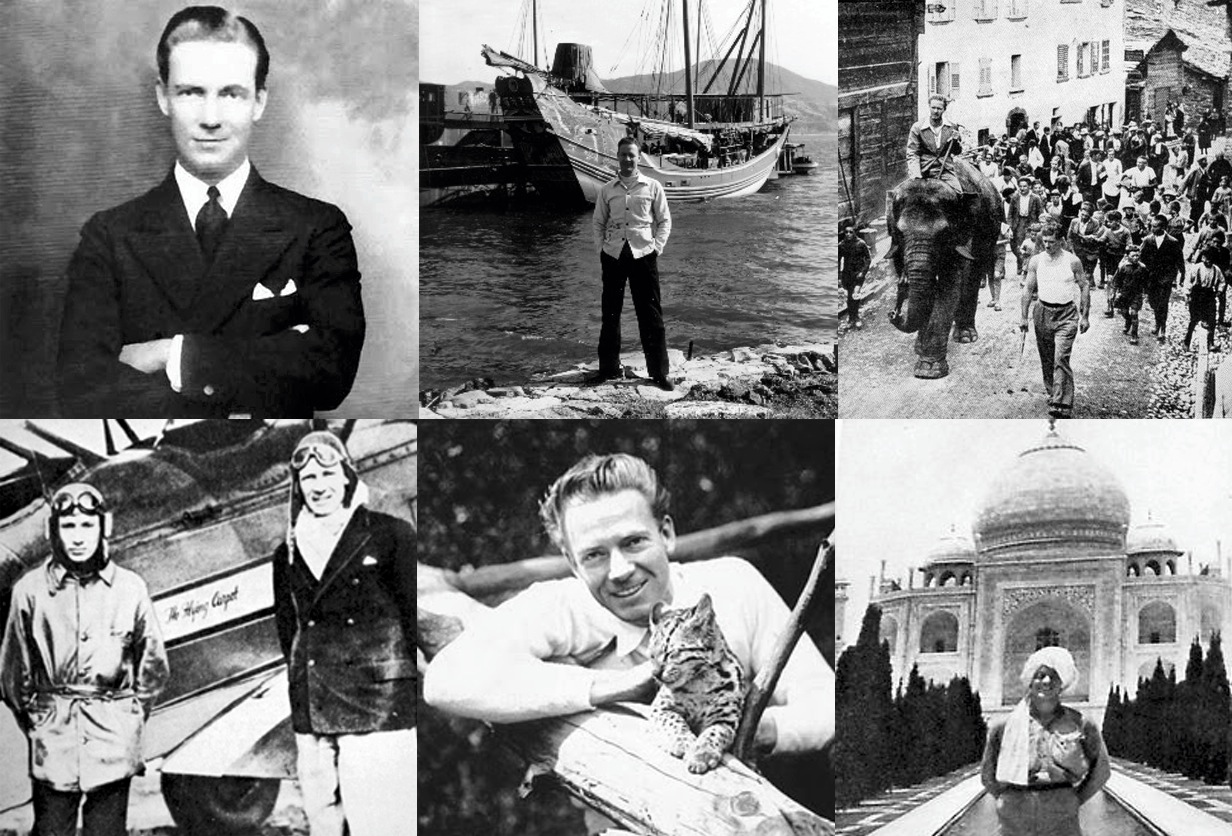 (Click for larger) Halliburton's sexual associations with members of his own sex became apparent. To protect the image of heroic masculinity he had cultivated to win over an admiring public, he kept secret his true sexual orientation. He seems also to have kept it a secret from his doting parents, who longed for grandchildren from their one surviving son. Among those romantically linked to him were film star Ramón Novarro and philanthropist Noel Sullivan, both of whom shared his enjoyment of the bohemian lifestyle. Halliburton's most enduring relationship was with freelance journalist Paul Mooney, with whom he often shared living quarters and who assisted him with his written work. In 1931 Halliburton hired pioneer aviator Moye Stephens on the strength of a handshake —for no pay, but unlimited expenses —to fly him around the world in an open cockpit biplane. The modified Stearman C-3B was named the Flying Carpet after the magic carpet of fairy tales, and this became the title of his 1932 best-seller. They embarked on "one of the most fantastic, extended air journeys ever recorded" taking 18 months to circumnavigate the globe, covering 33,660 miles (54,100 km) and visiting 34 countries. 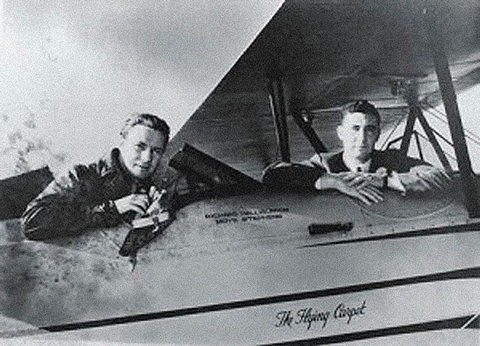 Halliburton (R) with Moye Stephens On March 3, 1939, Halliburton began to sail a Chinese junk across the Pacific Ocean. The Sea Dragon, a gaudily decorated 75-foot (23 m) junk, was made to his commission in the shipyards of Kowloon by cartwright Fat Kau. Emblazoned with a colorful dragon and equipped with a diesel engine, the Sea Dragon was supposed to make its maiden voyage from Hong Kong to the Golden Gate International Exposition in San Francisco (at Treasure Island). Three weeks out to sea on March 23 the ship encountered a typhoon. The junk was last sighted by the liner SS President Coolidge, itself battling mountainous seas some 1900 km west of Midway Island. That was the last seen the junk. After an extensive US Navy search with several ships and scout planes over thousands of square miles and many days, the effort was ended. In 1945 some wreckage identified as a rudder and believed to belong to the Sea Dragon washed ashore in California. Missing at sea since March, Halliburton was declared dead on October 5, 1939 by the Memphis Chancery Court.
1908 – Simone de Beauvoir (d.1986) is best known for her revolutionary study of women's condition, The Second Sex (1949), a work that changed women's lives worldwide. In 1999, an international colloquium was held in Paris to celebrate the fiftieth anniversary of The Second Sex. The conference included a number of papers on Beauvoir and lesbianism, a topic that, a decade earlier, would have been virtually unthinkable. In 1990, however, when Beauvoir's journals and two volumes of her letters to Jean-Paul Sartre were made available, it became clear that Beauvoir had had a number of same-sex relationships throughout her life. These revelations, along with others, completely shattered the heretofore unassailable myth of Simone de Beauvoir and Jean-Paul Sartre as the twentieth century's most perfect couple. Today, Beauvoir's same-sex relationships are widely acknowledged, although attempts to excuse them (as "bohemian existentialist experimentation," to give but one example), in the interest of preserving Beauvoir's heterosexual image, persist. Beauvoir was born in Paris into a bourgeois Roman Catholic family. Her family's fortunes declined after World War I, but she was nevertheless the beneficiary of an expensive private education. She then studied philosophy at the Sorbonne, where she met Sartre in 1929. From 1931 to 1941 Beauvoir taught philosophy in secondary schools in Marseilles, Rouen, and Paris. In 1943, she published her first novel, L'Invitée, one of several fictional works dealing with her relationship with Sartre. Although she herself seems not to have been involved in resistance efforts during the Nazi occupation of Paris, in 1945, soon after the end of World War II, she published Le Sang des autres, a novel reflecting on the question of political involvement and the French Resistance. The feminist classic The Second Sex followed in 1949 and was eventually to make her reputation. Her strongest novel, Les Mandarins, appeared in 1954; a semiautobiographical work, it too focused on her relationship with Sartre, the subject that has preoccupied both her autobiographical works and the scholarship devoted to her life and work. Beauvoir's same-sex relations, characterized by intense emotion and in most cases with a confirmed sexual component, likely began with Beauvoir's school friend "Zaza." Several of these relationships occurred during Beauvoir's career as a philosophy teacher during the 1930s and 1940s, and involved her students (who seemed to be the initiators, able to resist neither Beauvoir's physical nor her intellectual magnetism). In one case, Beauvoir's rendez-vous were structured around philosophy lessons. Exasperated at having to discuss Kant before climbing into Beauvoir's bed, the student Nathalie Sorokine called Beauvoir "a clock in a refrigerator." When Sorokine's mother complained to the school, Beauvoir was fired, effectively ending her teaching career. When Beauvoir was asked point blank in an interview if she were a lesbian, she angrily denied it. It should be noted, however, that Beauvoir tended to define things narrowly (she also claimed she was not a philosopher, again according to a strict definition). For Beauvoir, a lesbian is a woman who refuses to have anything (sexual) to do with males. Further, Beauvoir was a major participant in the public erasure of her lesbian identity. A comparison of the unpublished diaries with published works shows a very different representation of the relationship with Zaza in Beauvoir's autobiography Memoirs of a Dutiful Daughter (1958) or of Beauvoir's lover Olga as the fictional Xavière in her novel She Came to Stay (1943). It has only recently been recognized that Beauvoir was the model for the lesbian Inès in Sartre's No Exit (1944). In the early 1960s, Beauvoir began a relationship with Sylvie le Bon which lasted to the end of Beauvoir's life. In 1980, following Sartre's death, Beauvoir adopted Sylvie so that the latter could legally care for Beauvoir, who was to die six years later. Their relationship offers a model of the lesbian couple described theoretically in The Second Sex.
1924 – Sergei Parajanov sometimes spelled Paradzhanov or Paradjanov; (d.1990) was an Armenian film director and artist from the Soviet Union who made significant contributions to Ukrainian, Armenian and Georgian cinema. He invented his own cinematic style, which was totally out of step with the guiding principles of socialist realism (the only sanctioned art style in the USSR). This, combined with his controversial lifestyle and behaviour, led Soviet authorities to repeatedly persecute and imprison him, and suppress his films. In 1948 he was convicted of homosexual acts (which were illegal at the time in the Soviet Union) with a MGB officer named Nikolai Mikava in Tbilisi. He was sentenced to five years in prison, but was released under an amnesty after three months. In video interviews, friends and relatives contest the truthfulness of anything he was charged with. They speculate the punishment may have been a form of political retaliation for his rebellious views. Although he started professional film-making in 1954, Parajanov later disowned all the films he made before 1965 as "garbage". After directing Shadows of Forgotten Ancestors (renamed Wild Horses of Fire for most foreign distributions) Parajanov became something of an international celebrity and simultaneously a target of attacks from the system. Nearly all of his film projects and plans from 1965 to 1973 were banned, scrapped or closed by the Soviet film administrations, both local and federal, almost without discussion, until he was finally arrested in late 1973 on charges of rape, homosexuality and bribery. He was imprisoned until 1977, despite a pleas for pardon from various artists. Even after his release (he was arrested for the third and last time in 1982) he was a persona non grata in Soviet cinema. It was not until the mid-1980s, when the political climate started to relax, that he could resume directing. Still, it required the help of influential Georgian actor Dodo Abashidze and other friends to have his last feature films greenlighted. His health seriously weakened by four years in labor camps and nine months in prison in Tbilisi, Parajanov died of lung cancer in 1990, at a time when, after almost 20 years of suppression, his films were being featured at foreign film festivals. In January 1988, he said in an interview, "Everyone knows that I have three Motherlands. I was born in Georgia, worked in Ukraine and I'm going to die in Armenia."
1941 – Joan Baez is nothing less than a legend, both as a folk musician and as a catalyst for social change. A singer, guitarist, and songwriter with eight gold records and six Grammy nominations thus far, Baez has long been visible as a protest figure supporting civil rights, peace efforts, and human rights through her direct activism and numerous free concerts. Born on Staten Island, New York to a Scottish mother and Mexican-American father, Baez moved with her family to California when she was a small child. She lived in Baghdad from 1951 to 1952; there, confronted with rampant poverty and human suffering in the streets, she first realized her passion for social justice. Baez stood out as an artistic nonconformist and peace activist in her high school in Palo Alto, California, and then at Boston University—where she remained for only a short time. She had begun playing at local coffeehouses and decided to drop out of school in 1958 to concentrate on her musical career. Baez started playing in clubs such as Gate of Horn, which belonged to impresario (and Baez's future manager) Albert Grossman, and appearing with well-known musicians such as Pete Seeger. In 1960 her first album, Joan Baez, was released to huge acclaim. Gifted with an extraordinarily beautiful voice, she also brought an unusual intelligence to the interpretation of folk songs, both traditional and new. Baez became increasingly involved with the civil rights movement, using her growing fame as a means of drawing attention to a cause she believed in deeply. She especially worked in conjunction with Dr. Martin Luther King, Jr.; Dr. King's speeches and Baez's singing were a staple of demonstrations and rallies during the turbulent 1960s. Baez also became very active in promoting nonviolence. During the Vietnam War, she visited Hanoi for thirteen days to witness the horrors of war herself, and for ten years she withheld the percentage of her income taxes that would have been put toward military expenses. In 1967, she was arrested twice—and jailed for a month—for blocking the entrance of the Armed Forces Induction Center in Oakland, California. All the while she continued recording albums in her signature clear soprano, both writing her own material and performing classic songs of resistance such as "We Shall Overcome," "Oh, Freedom," and "Where Have All the Flowers Gone?" She founded both the Institute for the Study of Nonviolence (now The Resource Center for Nonviolence) in California in 1965 and the Humanitas International Human Rights Committee, which she headed from 1979 until its demise 13 years later. Although she may be most famous for her civil rights and peace activism, Baez has also been prominent in the struggle for gay and lesbian rights. She has been open about the relationship she had with a woman in 1962; in an interview a decade later, she told a reporter that she basically considered herself bisexual, a statement she stood by despite the controversy it sparked. She did marry activist David Harris in 1968, and had their son Gabe in 1969; although the couple eventually divorced, Baez never again pursued a lesbian relationship. Still, she has been visible in the gay community; in 1978 she performed at several benefit concerts to defeat Proposition 6 (the Briggs Initiative), which proposed banning all openly gay people from teaching in the public schools of California. Later that year, she participated in memorial marches for the assassinated San Francisco city supervisor, openly gay Harvey Milk. Alongside Janis Ian, she played a benefit for the National Gay and Lesbian Task Force in 1994, and has performed numerous times with the lesbian duo the Indigo Girls.
1961 – Peter Staley is an American HIV/AIDS-LGBT rights activist, known for founding the Treatment Action Group (TAG) and the educational website AIDSmeds.com. He is a primary figure in the Oscar-nominated documentary How to Survive a Plague. Staley was diagnosed with AIDS-Related Complex (ARC) in 1985, after seeing a doctor for a persistent cold. In 1987, after being handed a flyer on his way to work prior to the first demonstration by ACT UP (AIDS Coalition To Unleash Power), he decided to attend the next meeting. Although he had come out to his family, Staley remained closeted at work, working as a bond trader by day and chairing ACT UP's fundraising operations by night, before coming out at work and going on disability leave. On March 24, 1988, he took part in an ACT UP demonstration on Wall Street on the first anniversary of the group. At that demonstration, he was in one of the first waves of people sitting in the street to block traffic, and was interviewed by a local TV station who broadcast his image with the caption "Peter Staley, AIDS victim." On April 25, 1989, Staley and three other activists barricaded themselves in an office at Burroughs Wellcome in Research Triangle Park, NC to protest the price of AZT (at the time priced at $8,000-$10,000 per year). The four protesters used power tools to bolt metal plates to the door of an unoccupied office and had planned to drop a banner that would be visible from the nearby highway, Interstate 40, before authorities cut their way through a wall. On September 14, 1989, Staley and six other activists staged another demonstration to protest the rising cost of AZT, this time in the New York Stock Exchange. Within days, Burroughs Wellcome lowered the price of AZT by 20%. In 1989, he was part of a group that stormed the Fifth International AIDS Conference in Montreal, at the time a members-only event for doctors and HIV/AIDS researchers. Staley would be involved in many more demonstrations and protests, ultimately being arrested 10 times, although due to the work of pro bono lawyers, he doesn't have a criminal record. In 1991, Staley founded an ACT UP activist affiliate called TAG (which originally stood for Treatment Action Guerrillas, and later Treatment Action Group). Formed from ACT UP's Treatment and Data Committee, the group was focused on actively working to pursue AIDS treatment solutions through activism, and working with groups that had been targeted by ACT UP, such as pharmaceutical companies. As an event to launch the birth of the group, Staley draped a giant condom over the home of Senator Jesse Helms on September 5, 1991, protesting the position the senator had taken on AIDS-related issues. Staley features prominently in the 2012 documentary How to Survive a Plague, which depicts the early years of the AIDS epidemic and the actions of ACT UP and TAG. For the film, director David France relied heavily on archival footage, much of it taken from VHS tapes in Staley's personal collection. The documentary was nominated for an Oscar. It also received awards for the best documentary of 2012 from the Gotham Independent Film Awards and from the Boston Society of Film Critics, and was nominated for best documentary at the Independent Spirit Awards. In addition, the film was nominated for a Directors Guild Award and the Grand Jury Prize at the Sundance Film Festival, and won a GLAAD Media Award for Outstanding Documentary.
1964 – Ronald Dominique is an American serial killer from the Bayou Blue area of Houma, Louisiana. Dominique was investigated in late 2006 following a police report by a man who refused to let Dominique tie him up. The final victim, Chris Sutterfield, had died about two months earlier. Following his arrest on December 1, 2006, Dominique confessed to the rape and murder of at least 23 men over a ten-year period beginning in 1997, in Terrebonne Parish, Lafourche Parish, Iberville Parish and Jefferson Parish in suburban New Orleans. In his confession, Dominique, who is reportedly gay, said he frequented area gay bars and targeted men he thought would be willing to have sex for money. His reason for murdering these men was to avoid prison. Having raped the men he thought it would be better to kill them than have them report the assault to police. He was charged with multiple cases of rape and first-degree murder. On September 23, 2008, Dominique was sentenced to eight life sentences after confessing to raping and killing his male victims over a 10-year period. Dominique pleaded guilty to first-degree murder in a deal to avoid the death penalty. He is incarcerated at the Louisiana State Penitentiary.
1987 – Richard A. Fowler is an American radio show host, media personality, and political activist. Fowler is the host of the nationally syndicated liberal talk radio program, The Richard Fowler Show. As of 2019, he is serving as a Fox News Contributor. Fowler has been a featured speaker at the Energy Action Coalition PowerShift Conference, the Microsoft Policy Solution Center, over twenty different foreign delegations, and numerous colleges and universities. Fowler served as the Policy and Advocacy Director for the Young Democrats of America from 2011 to 2013. Fowler was a 2012 Democratic National Convention delegate for the state of Virginia. From 2011 to 2013 Fowler worked at the DC Public Charter School Board. On January 7, 2016 Fowler was made a Senior Media Fellow for the New Leaders Council,[6] a non-profit organization that works to recruit, train and promote young progressive leaders ranging from elected officials and civically-engaged leaders in business and industry. As a senior fellow, Fowler advises on the media, and electoral messaging and training. The Richard Fowler Show is a nationally syndicated weekly liberal radio show that can be heard in over 8.1 million homes. The Richard Fowler Show is also a partner in the TYT Network, a multi-channel network on , specializing in political talk shows, run by The Young Turks. Fowler is out as gay.
1994 – Elijah Daniel is an American comedian, rapper, and author. He became popular online through his comedy on YouTube and social media. Daniel is the author of the erotic novel Trump Temptations. His book went viral, and saw significant sales the day it was published; rising to the top of sales lists in multiple categories. Daniel's book received favorable reception. Trump Temptations became the top seller on Amazon.com in three categories: humorous erotica, LGBT erotica, and gay erotica. Elijah Daniel was born in Detroit, Michigan. He was raised evangelical Christian. After his grandmother became ill, Daniel moved into her residence to care for her. During this period, he began to write comedy to occupy himself. He publicized his comedy work through posts on Twitter, and videos to Vine. Daniel led an online White House petition in 2013 to make the Miley Cyrus song "Party in the U.S.A." the U.S. national anthem. It received international coverage. Starting in 2014 Elijah began hosting a weekly internet prank with CollegeHumor called Text Prank Thursday, where he would have his Twitter followers text random phone numbers saying whatever he told them to say. Daniel told Vice that he cultivated a group of followers online who appreciated his absurd and bizarre comedic antics. By 2016, his Twitter following had grown to over 95,000. In 2016 Daniel stated on Twitter that he was going to get drunk and write an erotic novel starring Donald Trump. Daniel was inspired by a tweet which said the user wished to perform a sex act on Bernie Sanders. Daniel wrote the work as a parody of Fifty Shades of Grey. Within four hours, he had released the erotic novel titled Trump Temptations: The Billionaire & The Bellboy on Amazon. The work was Daniel's debut novel. Trump Temptations became the number one best seller on Amazon.com in three categories: humorous erotica, LGBT erotica, and gay erotica.The book was listed on Amazon above Fifty Shades of Grey by E. L. James, and was featured in The Washington Post, Daily News, Los Angeles Times, GQ, Gay Star News, London Evening Standard, The Daily Telegraph, and Vice. The Guardian classed the work as part of the "small but burgeoning new genre: satirical books about Donald Trump" that began with the 2016 presidential campaign. Cosmopolitan called the book a literary success. Daniel hired Trump impersonator Chris Ferretti to read the audiobook. Trump biographer Marc Shapiro wrote in Trump This!, that Daniel's novel was one of the most infamous works capitalizing on interest in Trump. An article in Fortune said that Daniel displayed a Trump-like skill to capitalize on a niche demand. After the Orlando nightclub shooting in June 2016, Daniel publicly urged on Twitter for any individual who is closeted to feel free to contact him privately for support, and he published "An open letter to the LGBT kids who feel lost and scared" on Fusion.net. The letter positively received by ATTN:, which called it a powerful commentary on the attack. On August 30, 2017, Elijah Daniel performed a publicity stunt centered around Hell, Michigan – an unincorporated town that allows visitors to pay for the opportunity to hold the title of "mayor" for a day. In what he called "a copy-and-paste of Trump's Muslim ban", he announced a satirical law that banned heterosexuals from entering and living in the town. In response, Daniel released an edited version of The Bible called "The Holy Bible… but Gayer" two weeks later. Sales of it were briefly banned on Amazon before being restored.
In 1946, he joined what was then called the U.S. Army Air Force and became a chaplain's assistant at Lackland Air Force Base in San Antonio. Spires quickly took to the work, which included writing letters to families worried about their loved ones, playing organ during Catholic Mass and preparing the chapel for various services. When it became known that he was a homosexual he was given an "undesirable" discharge. Because of the repeal of Don't Ask, Don't Tell in 2010, it became possible for Spires to apply to have the status of his discharge changed. The 91-year-old Spires filed a federal lawsuit seeking an honorable discharge so he can receive a military burial.The Air Force has changed the 91-year-old's records to an honorable discharge. Spires said, "I can go to my grave with my head held high." [{(o)}]|[{(o)}]|[{(o)}]|[{(o)}]| [{(o)}]|[{(o)}] |
